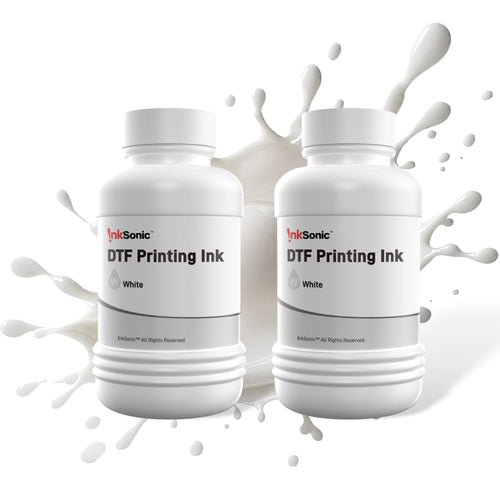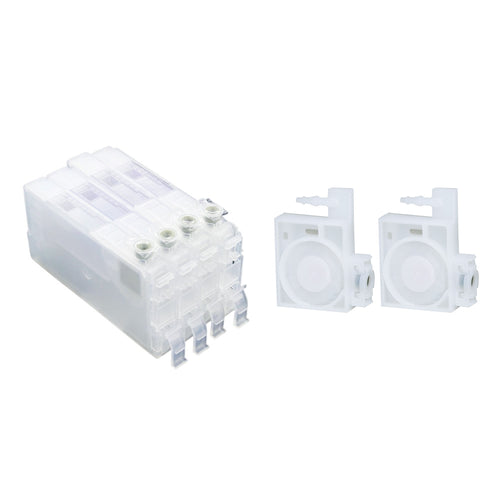If you’re planning to start—or expand—your custom apparel or transfer printing business, you’ve probably noticed there are two common sizes of DTF (Direct to Film) printers on the market: A3 DTF printers and A4 DTF printers .
In DTF printing, print size will determine how wide an area your designs will be able to cover—and how much you're able to do at one time. Even if they look identical, they can save you a ton of time, money, and effort when it comes to production and efficiency.
In this article here, we will explain how each of them works, the advantages and disadvantages, and assist you in deciding which is the better option for your business.

What Is A3 DTF Printer?
An A3 DTF printer, printing up to 11.7 x 16.5 inches, is the ideal choice for small-to-medium-sized enterprises requiring greater versatility and production capacity than an A4 model can offer. This added size of print allows designers to produce larger designs such as back prints on hoodies or large chest graphics on T-shirts, offering a more professional and eye-catching finish.
It's ideal for producing gang sheets too—printing up several small designs at the same time—that conserves film and ink, reducing cost-effectiveness. Apart from fashion, A3 DTF printers can be utilized to print customized textile panels, tote bags, and other fabrics. Miniature in size to fit in a studio yet strong enough for daily use, such printers find a balance between cost and capability and present themselves as a shrewd investment choice for start-ups and emerging brands.
Typical Features
An A3 DTF printer offers low footprint with the highest capacity for production in a package that's very well-adapted to small businesses, startups, and operators of side hustles. Twice the size of A4 printable space, the A3 dimension enables you to print more heavier designs or more graphs on a single piece of film, which enhances productivity and design adaptability.
While not so large as industrial-level DTF printers, this is still capable of professional-level output but still small enough to be installed in a home workshop or mini studio. While the initial cost and cost of running—such as ink and film—is higher than for A4, this extra cost is justified by faster speed of output, broader design opportunity, and the ability to produce more complex or bigger jobs.
What Is an A4 DTF Printer?
An A4 DTF printer with a maximum print area of 8.3 x 11.7 inches (usual letter size) is a perfect but compact solution for newbies and small businesses. Because of its compact size, it is especially suited for teen logos, T-shirt prints over the chest, kids' wear, and personal wear like sleeves, socks, and caps. Because of its compact size, it can fit easily on a small table or desk, and thus perfect for home offices, craft rooms, or temporary workspaces where one doesn't have much space.
Aside from its size, what really makes an A4 DTF printer appealing is that it is actually not very costly, and thus it is something within the means of even first-time business owners or sideline operators with limited budgets. It cannot handle big prints or bulk production like bigger models, but it suffices in making personalized, high-quality designs in minimal quantities.
Typical Features
Perhaps the biggest draw of an A4 DTF printer is the way that it balances small size with economy, so that it is a highly desirable product among hobbyists, weekend sellers, or small Etsy store owners. Having a smaller print bed, this style of printer consequently consumes less ink and film per print, keeping a given day's operating costs low.
The small size has it occupying a space of honor on a desk, table, or home studio nook, allowing creators to get started with printing without having to reserve a dedicated space. Apart from the space-saving advantage, the lower starting price compared to big A3 or industrial machines places it at a pole position for anyone testing the waters with customized printing or running a creative side hustle.
While it may not be suitable for big back prints or huge orders, the reduced ink consumption and low running costs enable you to still produce high-quality, personalized products without a high price tag. That positions an A4 DTF printer as a good starting point for realizing innovative ideas without being exposed financially.
Key Differences Between A3 and A4 DTF Printers
Let’s break it down into the main areas that matter to business owners:

Print Area & Design Flexibility
A3 printers let you print larger graphics, gang sheets, and save film by combining multiple designs on one sheet. This is especially valuable if you sell different sizes or types of products.
With an A4 printer , you’re limited to smaller designs. This might be fine if your business focuses on simple chest logos or kids’ clothes—but it becomes frustrating if you get larger custom requests.
Productivity & Efficiency
A3 printers often have faster print speeds and can handle more designs per day. Plus, the ability to print larger gang sheets means you spend less time changing films.
In contrast, A4 printers are slower and less efficient for bulk orders. If you receive a rush order of 100 shirts, an A3 setup can finish hours earlier.
Cost Considerations
A3 DTF printers cost more upfront (sometimes double or triple an A4).
Film and ink usage is higher per print—but the profit per shirt also increases because you can charge more for larger or more complex designs.
A4 DTF printers have lower entry costs and use less ink and film per design. But your price per shirt may need to stay low to match what you can print.
In terms of ROI, an A3 printer can pay itself off faster if you’re doing medium-to-high volume or selling larger prints.
Space & Environment
An A4 DTF printer can go almost anywhere: home office, spare room, or even on the corner of a desk.
A3 printers also need more space, especially if you add a powder shaker and dryer. Make sure your room or workshop has enough space for the extra equipment.
Creative Things You Can Produce Using A3 & A4 DTF Printers


Beyond the mere printing of T-shirts, DTF printers unleash an enormous realm of imaginative and profitable products to small business owners and makers alike. With A3 and A4 printers, one can effortlessly print personalized products such as tote bags, pillowcases, pet clothing, patches, sleeves, socks, baby onesies, hats, and fabric panels.
The difference will most often be in terms of size and complexity: an A4 DTF printer will be adequate for small applications like logos on hats, kids' wear, small patches, and bespoke sleeves, where print areas rarely go beyond standard letter sizes (8.3 x 11.7 inches).
On the contrary, the broader print zone of an A3 printer (11.7 x 16.5 inches) allows one to handle full-chest prints, large back photos on hoodies, small design gang sheets, and special fabric panels like pillow covers or larger tote bags.
Which One Should You Choose?
It really comes down to your business goals, space, and budget.
Here are a few practical questions to help decide:
How big are the designs you want to print?
Mostly logos? A4 might be enough. Large back prints? You’ll need A3.How many shirts do you plan to print per week?
Just a few orders? A4 is fine. Planning to scale up? A3 is better.What’s your budget?
A4 keeps startup costs low, which might matter more when cash flow is tight.
Do you have the space?
If not, an A4 is easier to fit into a small room or home office.
Pros & Cons Summary Table
Feature |
A3 DTF Printer |
A4 DTF Printer |
Max print area |
Larger (11.7 x 16.5 in) |
Smaller (8.3 x 11.7 in) |
Gang sheet capability |
Excellent |
Limited |
Productivity |
Higher |
Moderate |
Initial cost |
Higher |
Lower |
Operating cost |
Higher |
Lower |
Space needed |
More |
Less |
Ideal for |
Mid/high-volume shops, large prints |
Low volume, small designs, home-based businesses |
Conclusion
Choosing between an A3 DTF printer and an A4 DTF printer isn't just about size—it's about your vision, your market, and where you see your brand going.
If you are a beginner in business, occupy little space or do only small designs, an A4 printer will get you into the DTF business quickly and inexpensively.
If you are expanding, handling large orders, or providing more detailed prints, an A3 printer will save you time, increase your design size, and boost your long-term profit.
At InkSonic, we help small business owners, artists, and entrepreneurs choose the right DTF printer—whether that is A3 or A4—to suit their personal journey.
The following is a comparison table of all printer models sold by InkSonic. You can choose according to your needs.
| Features/DTF Pinter Model | C13 | E13 | C13A | E13A | U13 | U13D | L13 | L8 |
|---|---|---|---|---|---|---|---|---|
 |
 |
 |
 |
 |
 |
 |
 |
|
| Printhead | L1800 | L1800 | L1800 | L1800 | XP600 | XP600*2 | XP600 | XP600 |
| Print Size | 13inch | 13inch | 13inch | 13inch | 13inch | 13inch | 11.8inch | 8inch |
| Occupies | 28.75*11.2 inch (730*300mm) | 28.75*11.2 inch (730*300mm) | 28.75*11.2 inch (730*300mm) | 28.75*11.2 inch (730*300mm) | 25.6*13.39inch (650*340mm) | 25.6*13.39inch (650*340mm) | 20.87*14.97inch (530*380mm) | 15.95*14.18inch (405*360mm) |
| Print Speed | A3/5-8 mins | A3/5-8 mins | A3/4-6 mins | A3/4-6 mins | A3/3-5 mins | A3/2-4 mins | A3/3-5 mins | A4/2-4 mins |
| Unit per Hour | 8 | 8 | 10 | 10 | 12 | 20 | 12 | 15 |
| DTF Supplies Cost per T-shirt | $5.8 | $5.8 | $5.8 | $5.8 | $5.8 | $5.8 | $5.8 | $5.8 |
| Maximum Print Resolution | 2880x1440 DPI | 2880x1440 DPI | 2880x1440 DPI | 2880x1440 DPI | 2880x720 DPI | 2880x720 DPI | 1440x1440 DPI | 1440x1440 DPI |
| Color Reproduction | 100% | 100% | 100% | 100% | 98% | 98% | 98% | 98% |
| RIP Software Features | Ordinary | Ordinary | Advanced | Advanced | Advanced | Advanced | Ordinary | Ordinary |
| Suitable Material | Almost All Fabrics | Almost All Fabrics | Almost All Fabrics | Almost All Fabrics | Almost All Fabrics | Almost All Fabrics | Almost All Fabrics | Almost All Fabrics |
| Working Environment | Normal | Normal+Cold | Normal | Normal+Cold | Normal+Cold | Normal+Cold | Normal | Normal |
| Heating Tray | / | ✔ | / | ✔ | ✔ | ✔ | / | / |
| Film Cutter | / | / | ✔ | ✔ | ✔ | ✔ | / | / |
| First Automatic Ink Filling | / | / | ✔ | ✔ | ✔ | ✔ | ✔ | ✔ |
| Air Suction System | ✔ | ✔ | ✔ | ✔ | ✔ | ✔ | / | / |
| With Shaker & Dryer | X | X | X | X | ✔ | ✔ | X | X |
| Warranty | 6 Months | 6 Months | 6 Months | 6 Months | 6 Months | 6 Months | 6 Months | 6 Months |
| Holiday Auto Nozzle Cleaning | / | / | / | / | ✔ | ✔ | / | / |
| Nozzle Cleaning Frequency | Every 3 Days | Every 3 Days | Every 3 Days | Every 3 Days | Every 2 Days | Every 2 Days | Every 2 Days | Every 2 Days |
| Maintenance Frequency | Rarely | Seldom | Rarely | Seldom | Occasionally | Occasionally | Rarely | Rarely |
| Ease of Maintenance | Moderate | Moderate | Easy | Easy | Very Easy | Very Easy | Very Easy | Very Easy |
| Ink Anti-clogging | Circulation, Mixing, Filtration | Circulation, Mixing, Filtration | Circulation, Mixing, Filtration | Circulation, Mixing, Filtration | Circulation, Mixing, Filtration | Circulation, Mixing, Filtration | Circulation, Mixing | Circulation, Mixing |
| Powerful Ink Flush | / | ✔ | / | ✔ | ✔ | ✔ | ✔ | ✔ |

































